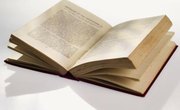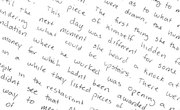There are two designations for a "strong" verb: one is grammatical and one is aesthetic. In grammar, the "strong" verb is an irregular verb that forms the past tense with a vowel change: "run" becomes "ran," "swim" becomes "swam," "come" becomes "came." It is "strong" because its changes are self-contained, whereas a regular, "weak" verb needs a -d or -ed ending to complete itself: "jump" becomes "jumped," "color" becomes "colored," "create" becomes "created."
Classic Poetry with Strong Verbs
In aesthetics, however, the "strong" verb in a poem is the one that motivates the flow and rhythm of the poem, and produces the most vivid imagery. In Sonnet 21, Shakespeare writes "Shall I compare thee to a summer's day"; even though "compare" is the motivating verb of the poem, it is grammatically weak. The best determiner of strength combines both ideas: three lines into his poetry, Shakespeare writes "rough winds do shake the darling buds." "Shake" fulfills the definition both grammatically and aesthetically, producing the most vivid image.
Modern Poetry with Strong Verbs
Harold Bloom in "How to Read and Why" examines Wallace Stevens' poem "The Palm at the End of the Mind" and finds that the poet's verbs are both grammatically strong and aesthetically vivid: "The bird sings. Its feathers shine. The palm stands on the edge of space." Bloom notes that the verbs are all strong grammatically, and combine to create an "ambiguous" picture of "assured phenomena," indicating they are also strong verbs in the aesthetic sense.
Dickinson Defies the Rules, Again
As always, Emily Dickinson defies the rules in her poems, using weak, regular verbs as the poem's strongest, most powerfully motivating forces. In Poem 1260 she uses as her central verbs a somewhat passive selection: "overlook," "suspend","live," "detect," "annihilate," "perceive," "recognize," "doubt," "exchange," "reprehend", "commute," "admit" and "refund." Every single verb is grammatically weak; nonetheless, they are the most powerful elements of the poem's flow and rhythm. It is as if Dickinson is rejecting correct grammar -- she usually does anyway -- in favor of natural strength of imagery.
What a Strong Verb in Poetry Is
In answer to the question "What are the strong verbs in poetry?," the answer lies in the kind of verb being examined. Grammatically "strong" verbs are easy to spot: they substitute vowels in past tense. Aesthetically strong verbs need some examining. If they provide a flow, a force or motivating imagery to the thrust of the poetry, they may be grammatically weak but are still poetically strong.
Related Articles
References
- Warriner's English Grammar and Composition: John E. Warriner
- The Riverside Shakespeare: Sonnets
- How to Read and Why; Harold Bloom
- Complete Poems; Emily Dickinson
Writer Bio
Michael Stratford is a National Board-certified and Single Subject Credentialed teacher with a Master of Science in educational rehabilitation (University of Montana, 1995). He has taught English at the 6-12 level for more than 20 years. He has written extensively in literary criticism, student writing syllabi and numerous classroom educational paradigms.











